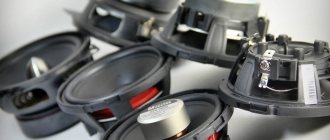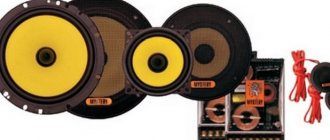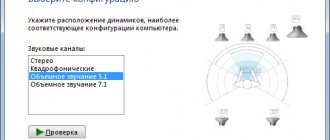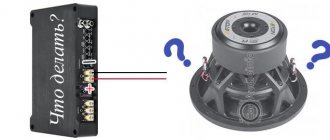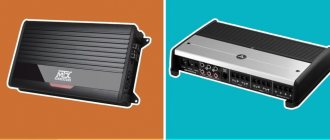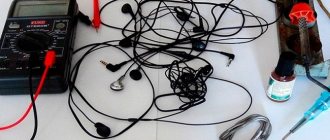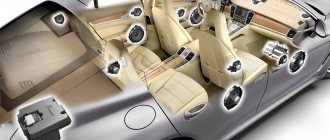Often, many car enthusiasts are not satisfied with the sound of the standard audio system installed in their cars. And, of course, I want to replace it. The market is overcrowded with a range of products in this category, which naturally makes it difficult to choose a high-quality sounding speaker system.
Speaker
How to choose the right audio system without additional costs and installation problems?
How to choose acoustics for a car.
There are a lot of companies producing acoustics, some of them are cheap Chinese, and some are very good and have a solid reputation.
So how can you tell them apart? In fact, this is very difficult to do. The rule of 10 companies written in the previous article no longer applies here, because There are already more than 200 manufacturers on the Russian market, and many of them are very good.
Young Chinese companies are also not exactly junk, but many sellers present them as cool American (European) ones, and sell them for two to three times more than their true price. The main thing is not to run into such companies and not buy acoustics for 100 dollars, the true price of which is 35-40. Here is a list of some companies (not all) that are worth buying: DLS, MTX, JBL, Focal, Hertz, Rockford Fosgate, Magnat, Boston Acoustic, Alpine, Blaupunkt, Nakamichi, Lightning Audio, Infinity, Morel. Companies such as Sony, Pioneer, Kenwood, JVC, Panasonic are certainly not leftist, but I would refrain from buying acoustics from such manufacturers, because their sound is average, and the price is often very high, although they also have very worthy copies (especially if they are on sale).
When choosing acoustics in a car, you need to follow some rules:
1. The speaker suspension must be rubber (not fabric).
2. It is better to install spaced-apart acoustics (with separate tweeters) in front. It is better to use silk tweeters, because... their sound is softer, smoother and more detailed than others.
3. It is better to install acoustics in the back measuring either 6x9" (pancakes) or 17-20 cm.
4. The speakers should be fixed as tightly as possible. It is better to attach it to metal or wood.
5. If you need good sound, then it is better to install the front speakers in a podium.
6. If it is possible to install acoustics with a larger diameter, then it is better to do so.
The systems in the car are divided into 4 levels:
— mid-level system,
- high level system,
— competitive class system.
When choosing acoustics, first of all you need to proceed from the system you have chosen. Let's consider each of them separately.
In this case, I would advise installing inexpensive speakers from good companies. You can take acoustics from a not very well-known company, the main thing is not to run into a Chinese counterfeit. You can place both spaced and coaxial speakers in front. Back - pancakes. Price: front 20-40 USD, rear 30-50 USD It’s not worth installing more expensive acoustics, because... The simplest system is good and not expensive.
Mid-level system.
In this case, it is better to put forward the delivery of a good company and preferably with a silk tweeter. You can also think about installing front speakers in the podiums.
It's best to put the pancakes back. If you want to save money, it is better to buy cheaper speakers back and more expensive ones ahead. The main thing in car sound is the front speakers.
Example: front: rear: DLS B6 — $95 DLS1269 — $56 Magnat Clasic 216 — $85 Magnat Clasic 694 — $70 Alpine SPS-171A — $80 Nakamichi 692 — $70
As you can see in all the examples, the front speakers cost more than the rear ones.
High level system.
In this case, the choice of acoustics must be approached as seriously as possible. In general, you need to start choosing this system with acoustics, first putting in the highest quality separation (as much as your budget allows). They must not only be good in terms of sound, but also powerful in order to withstand the power of the amplifier. It is better to install them on podiums and soundproof the door. Back, depending on the system layout: if the rear speakers play directly from the radio, then you can use not very powerful speakers, but if from an amplifier, then the acoustics should be powerful. In both cases, the rear speakers should not pull the soundstage back. Therefore, back I would also recommend acoustics with a silk tweeter. If you put speakers with a metal tweeter in the back and a silk tweeter in front, the rear speakers will “whistle” so much that you will hear them, and the high-quality top of the front speakers will completely fade away in the “ringing” from the rear. The task of the front is to reproduce as full a range of frequencies as possible: top, middle and, if possible, upper bass. The rear's job is to add upper bass without pulling the soundstage back. The sub's job is to pump up the lower bass. You can place both coaxial and spaced speakers in the back, although there is no particular point in spaced speakers.
Competitive level systems.
In these systems, a 3-component system is put forward, as high quality and expensive as possible. For component speakers (tweeters, midrange and midbass), places are chosen so that the sound stage is as wide and deep as possible. Rear speakers, as a rule, are not installed at all, but not one, but two pairs of speakers are placed in front. Typically, channel amplification is used, that is, the tweeters are powered from one pair of amplifier channels, the middle from another, and the bass from a third. Choosing acoustics for these systems is quite difficult, so the choice should be entrusted to professionals.
When choosing acoustics, you need to take into account the nature of the sound that you like. Some people need a natural, natural, rich sound with deep and correct bass, some people want the sound to be loud, the top to ring, and the bass to squeeze their heads (like at a pop disco). For the former, I would recommend European components with silk tweeters (DLS, Magnat, Morel, Focal, Hertz), for the latter, American components (Boston Acoustic, Lightning Audio, Rockford Fosgate, JBL). Which sound is better is up to you to decide. I noticed that beginner sound lovers prefer American (disco sound), while more advanced ones prefer European. Also, do not forget about the problems of compatibility of head units with acoustics. Some car radios play well with some speakers and not at all with others. Based on materials from: avtoforum71.ru
Source
We determine the required resistance, sensitivity and other parameters
The electrical characteristics of acoustics play a large role in the formation of high-quality sound and the overall functional suitability of an individual loudspeaker. Each speaker or column is selected according to the following criteria:
- Resistance. It is desirable that this characteristic corresponds to the value specified in the radio data sheet. In this case, the acoustics will operate normally, without causing signal distortion from the amplifier.
- Sensitivity. On the one hand, this parameter describes how quickly the speaker responds to signal changes. On the other hand, it describes sound pressure. When it comes time to choose acoustics, it is worth remembering one feature of the car power network. It contains quite strong interference. Therefore, it would be wrong to choose speakers with high sensitivity. A reasonable solution would be to buy acoustics with a parameter value in the range of 90-95.
- Good quality. This parameter describes how strongly the inertia of the diffuser affects the correct reproduction. For speakers installed in cars, it is advisable to choose speakers with a Qts indicator of at least 0.6.
The last and most important thing is the choice of speaker power. Based on the physics of the operation of the amplifier and the mechanics of signal delivery at different periods of time, it is worth relying on the following postulates.
- The rated power of the acoustics should be at least one and a half to two times higher than the value specified in the passport for the radio. This is the main requirement for car speakers.
- The maximum power should not be less than three times the amplifier rating. This is a desirable, but not mandatory, compliance requirement.
- In some cases, when the speaker manufacturer specifies peak rather than maximum power, it is worth choosing a product that has an exact threefold reserve (or higher).
Some selection principles are worth explaining. The stated speaker power rating is based on testing. The acoustics are supplied with a signal in a wide range of frequencies. The test is carried out according to the scheme one minute of work - two minutes of downtime.
Therefore, the rated power means a certain technical maximum, which is achieved when reproducing an average audio signal with a variable volume level.
It is not at all guaranteed that the speaker will not burn out if the amplifier supplies it with rated power with values close to the peak for hours. Therefore, it is recommended to take one and a half or double margin when choosing speakers. This ensures the performance of the acoustics when playing music for hours and even days.
The maximum power shows the parameters of the input signal that the speaker can withstand for a minute (for some manufacturers up to 5 minutes). This parameter is not measured by testing. It is calculated based on winding characteristics and other engineering parameters.
In real conditions, the radio can burn out the speaker with a sudden surge of power close to its maximum. Therefore, it is also recommended to have a threefold margin for this parameter, mainly to prevent overheating of the winding.
Peak power characterizes the speaker's chances of surviving a short-term intense signal pulse. This data is obtained by the manufacturer as a result of testing a batch of products. Therefore, if the acoustics data sheet indicates exactly the permissible peak power, a choice with a threefold margin is mandatory.
What speakers should I put on the front doors?
If the owner of a car loves music, then he will need high-quality car acoustics. The interior of a passenger car is a small closed volume, which makes high-quality sound reproduction difficult. Listening to music tracks is affected by the noise from a running engine. A negative factor when installing speakers in car doors is also the vibration of metal surfaces, so when installing the speaker system yourself, you need to follow useful recommendations.
Dimensions of standard car speakers
Round speakers (see photo) are one of the most popular speakers, built under metal mesh in the dashboard, in panels under the dashboard, in the doors, and also on the sides of the rear panel. 16.5 cm is the most popular speaker size.
Oval speakers (see photo) - mounted in mounting panels or on the side on the rear shelf, as well as in doors. 15x23 cm is the most common speaker size.
What speakers are best to put in the front doors?
Speakers are placed in different places inside the car. To provide sound for the first row of seats, speakers are installed in the front doors. Depending on the technical capabilities and design of the car, the speakers in the front doors can be coaxial or component. Coaxial acoustics are two or three loudspeakers that are mounted in the center of one of them. The main one is a 6.5-inch low-frequency or wide-range loudspeaker, on which there is a mid-range driver and a tweeter for reproducing high frequencies. The decision on which 16 speakers to install in the front doors is often determined by the make and design of the car.
The coaxial audio system has good playback quality and is compact. The dimensions of the acoustics are determined by the dimensions of the main speaker. What is important for the car owner is the relatively low price of the design and ease of installation. Due to the fact that all acoustic devices are arranged in one place, it is impossible to set the relative position of the dynamic heads to obtain effective sound.
Component acoustics, designed for installation in the front doors of a car, consists of several dynamic heads, each of which is mounted in its own place. The entire reproduced audio range is divided into several bands, so component speakers are connected to a low-frequency amplifier through crossover filters or crossovers. The number of loudspeakers must be at least two, and high-quality sound reproduction devices require connecting acoustics with 4-5 loudspeakers per channel. This configuration increases the power and sound quality, the cost of the system and the complexity of installation.
How to determine the power of a radio
First, a little theory. The power of any playback device to which the car radio speakers are connected cannot exceed the parameters of the on-board electrical network. In the case of a sound system, this is a voltage limit of 12 V. From the standpoint of pure physics, the head unit or radio cannot have a power per channel higher than 4.5 W.
The correctness of this statement is confirmed by extremely cheap electronics options. If you buy, for example, a tape recorder for 400-500 rubles, it will produce just such a small power and the speakers for the car radio should be selected accordingly.
Modern middle-class electronics work with a bridge circuit. Its amplifier can produce up to 18-20 watts of pure power. If there is a model in the store with such parameters, you can safely buy it, because it will not throw up any surprises. A product of this type works physically correctly, according to the classical scheme; the speakers selected for the car radio are guaranteed not to experience unexpected overload and fail.
But what do the magic numbers of 45, 50, 80 W mean at the output of the car radio amplifier, proudly duplicated by inscriptions and stickers on the front panel? This is both a marketing lie and a technical trick. An intermediate power storage device is installed in the amplification circuit of such models. This is a capacitor that is charged during the period of time when the sound picture allows operation at a signal power below 20 W.
During a period of increasing amplitude, for example, during a sharp hit of a drum or a powerful increase in the volume of a track, the capacitor releases energy and the amplifier exceeds the physically correct signal level. This approach takes advantage of the characteristics of human hearing. When the capacitor's charge runs out, the overall volume drops, but the person does not notice this due to the effect of inertia of perception.
Based on an understanding of basic physics, it is easier to understand what exactly the data indicated in the data sheet for the radio means.
- Power in Watts - peak value of the signal, short-term. If the device documentation provides a PMPO value, it does not require conversion and can be used as a guide when choosing speakers for the radio. In the case when RMS power is given, the indicator must be divided by 1.41 to obtain the desired parameter.
- Sound scheme. Today, a standard stereo system is quite rare in market offerings. A regular radio has 4 or 5 output channels and can be equipped with a separate subwoofer connection port.
All data can be found in the documentation for the sound-reproducing device or looked at the tag placed on the case. The information obtained will be used when it comes time to select speakers for the car radio based on power.
What speakers should I put in the front doors?
The main criteria when choosing acoustic systems for passenger car doors are the technical parameters and the manufacturer. In some cases, a coaxial system from a reputable manufacturer will provide higher sound quality than a low-quality multi-component system. Which speakers to install in the front doors depends on their design. Electrodynamic heads of large diameter are usually not used for this purpose. The optimal size of acoustic emitters for installation in doors is 6.5 inches in diameter. This will allow you to get a loud sound for a car interior and good reproduction of low frequencies.
Installing a speaker in a door is not a difficult task, except in cases where the dimensions of the speaker do not allow it to be installed in the seat. The issue is resolved by using a special podium. A component speaker system is often placed in the podium, but the design of the car interior will be slightly disrupted. Often, lovers of good music in the car interior use loudspeakers with a diameter of twenty centimeters or eight inches. Such large car door speakers provide high-quality reproduction of mids and low frequencies, but the dimensions of these speakers are a serious obstacle when installing them in a car door.
Choosing an audio system
First you need to determine the dimensions of the speakers that will be installed in the standard holes prepared for them when assembling the car. All speaker systems that are offered to customers have several standard sizes. Speakers installed in cars by manufacturing companies sometimes have overall dimensions that occupy a middle position between the proposed standards. But it's not scary. In order to switch to selected speakers with a certain standard of overall dimensions, it is necessary to prepare podiums for them, replacing the former standard plastic ones with those chosen by the car owner.
Installing speakers in the front doors
To decide which speakers are best to install in the front doors, you must first select sound-reproducing equipment, since the parameters of the speaker system depend on the characteristics of the low-frequency amplifier. The main parameters of the amplifier are power, distortion factor and number of channels. Which speakers are best to choose and install in the front doors. Good speakers are now being produced that are recommended for use in the front doors of a car. Their diameter does not exceed 7 inches, and they have good bass reproduction quality. Electrodynamic heads with a diameter of 13-15 centimeters are often used for rear audio. If the car doors do not allow the installation of larger diameter systems, then they can also be used as the main front emitters. Only low frequency reproduction will be limited.
Do you need rear speakers?
Hello everyone, this situation arose a long time ago, when there was no subwoofer, there were 6x9 speakers in the rear shelf, when I installed the subwoofer, I removed them, and now I’m thinking whether I should put it back or not. Front: Focal ps165 (midbass in the doors in the standard position, tweeters in the corners) Rear: Mb Quart onx169 (is it worth putting them in the rear parcel shelf?) Amplifier: Audison srx5 Amplifier: Hertz ep1d
Yes, they and the sub are not needed together. The porridge will turn out
I also thought so, that they would f*ck, but in the installation they suggested something, and I thought about something, maybe they should be stuck in the doors, I applied a net, it looks like they should go in
the door is not very 6*9 designed for a larger volume but rather for the design of a Free Air
I also thought so, that they would f*ck, but in the installation they suggested something, and I thought about something, maybe they should be stuck in the doors, I applied a net, it looks like they should go in
My brand had a sub and 6*9. Disabled 6*9 it became more pleasant)
Thanks for the advice, basically as I thought, they were misleading in the installation
Bet, who's stopping you? Or are you looking for your twin brother here? Who has the same car, the same components, listens to the same music?
I'm talking about the fact that, whether it will be better or worse, the sub and speakers will play in the same volume
You should listen to this, not us. How can we know how you will feel better?
There is not only how it will be better for me, but how it should be right, people’s experience, so I ask people who have had experience...
What does right mean? And if the sound is unpleasant to you, but it’s the right thing to do, will you drive like that?
correct means that the speakers should play in volume, and is it correct if the speakers play in the volume of the trunk where the sub is installed. I didn’t ask to read a lecture here, but advice from people who understand and can help, forgive me, it’s no use 0
You're no more useful. What kind of sub? What is the design of the subwoofer? What's with the shelf? PHOTO WHERE?
Well, tell me to post it, and not give lectures on the topic “only you know how it will be better for you”
You are so funny... Do you think that someone knows better than you about what you yourself need? A question the answer.
For the last time I’m answering you, I asked whether the acoustics would play worse if you installed speakers in the rear parcel shelf. The person who wrote above gave advice based on experience, but I see you are only trying to teach, there is no advice - why write then?
One will be worse, the other will be better. You won't know until you put it in.
ok, I heard your opinion, thank you
I'm driving 1, it's equipped with front and sub. There is no need for rear pancakes at all. The only thing is that those driving behind are a little dissatisfied that the sound is not enough for them, they have to turn up the volume and it turns out that it’s loud in front, but good in the back)) the system is loud on purpose, but you can’t listen to it loudly all day long)) But for my system, pancakes are not going anywhere they resist and are not needed. So, I don’t care about the wishes of the passengers)) whoever rides in front gets a kick out of it))
Yes, everything was also fine, but recently I stopped by the installation center, the guys listened and started to add more speakers to make the sound more spacious, and somehow now I’m driving and it’s true - it seems like it’s not voluminous anymore, there’s no support from behind. But maybe you just need to fiddle with the settings
what program to use to make an apartment plan
Well, in general, putting dins in the same volume as a subwoofer is not correct. It can simply squeeze them out. I threw mine out of the back shelf. If you want to come up with something for the rear passengers, there are better options to consider. But you don't need rear speakers for yourself. Firstly, the sound from them will reach you with a delay. And secondly, the sound from the 6/9 speakers itself is not very good.
Source
How to properly install speakers in the front doors of a car
Installing multiple speakers in a door requires special work. They are difficult to perform at home, so many car owners turn to service centers. They know well how to properly install speakers in the front doors. It is difficult to install component speakers yourself, so contacting a car service center will be justified.
If you need to replace your “original” speaker systems with other models, and remaking the standard seat is impossible or undesirable, then it is recommended to use oval speakers 13 x 18 cm, which reproduce low frequencies well. If you plan to install sound emitters with a diameter of 10 cm, you need to know that they will not provide sufficient reproduction of low frequencies and the car’s speaker system will have to be supplemented with additional bass support.
Car speakers for front doors
Installing speakers in the front doors often involves the use of podiums, which allow powerful speakers to be placed in the front of the cabin for high-quality sound reproduction. Here a lot depends on the choice of speakers. Which ones to choose and how to install speakers in the front doors is a difficult task for a non-specialist. Small acoustic heads cost much less than large devices, but those who need high-quality sound should not buy them.
Manufacturers of compact speaker systems advertise small-diameter drivers that reproduce low frequencies well. This is true, but when installing small-sized speakers, other characteristics will be noticeably reduced. The timbre will be dry and flat, and the tonal balance will be disrupted.
It is important to know
Car acoustics.
How to choose car audio?
Before you go to the store for a speaker system, decide for yourself where it is best to install the speakers in your car. If in “regular” places, find out what size speakers they are intended for. For example, in many domestic cars, without additional expenditure of time and money, you can install only the smallest ones, with a diameter of 10 - 13 cm. If the speakers you like do not fit in size, then you will have to install them on a “podium”.
Also try to decide in advance which speakers to buy, coaxial or component. It is almost impossible to get good sound from a coaxial speaker system (in which speakers of all frequencies are collected in one “basket”). Therefore, it is better to opt for component speaker systems: with separate LF-MF (low and mid-frequency) midbass speaker and HF (high-frequency) speaker (aka tweeter or tweeter). If you like deep sound, then when choosing “midbass”, do not save money and do not buy 4 - 5-inch (10 - 13 cm) speakers. It’s better to take models 16 - 17 (6 - 6.5 inches) centimeters diagonally. Unlike small speakers, low frequencies (bass) will also be clearly heard in them.
The most complete information about acoustics can be obtained from the instructions. You just need to know what to look for. The sound quality is affected by three main parameters, which must be reflected in the instructions.
1. Sensitivity
(sensitivity). The higher the sensitivity, the better the speakers will play without an amplifier. Speakers with a sensitivity of 84 - 86 without additional signal amplification will play barely audible.
2. Resonance frequency
(Fs). The lower it is, the deeper bass the speaker can produce. The optimal indicator for a strong “midbass” is 60 - 75 Fs.
3. Overall quality factor
(Qts). For speakers that will be installed in doors, it should be as high as possible. If QTS is 0.4 - 0.6, the music will sound bad. Such speakers require dedicated space (a closed box of 5 - 12 liters).
The purity of the sound depends not only on the speakers and receiver, but also on the conscientiousness of the technician installing the acoustics. The stronger the midbass is installed, the better. He doesn't need any extra vibrations! If the speakers are installed in doors, spare no expense on sound and vibration insulation. Then the doors won’t rattle at high volumes, and the bass will sound much better.
If you decide to install the speakers backwards, remember that there must be enough free space between them and the subwoofer (if you install one). The best solution in this case: speakers - in the rear doors, subwoofer - in the trunk. If possible, “power” the receiver and amplifier directly from the battery to avoid interference, wheezing and sound distortion when the engine is running. But the wires that go from the “head” to the speakers, contrary to popular belief, do not have much influence on the sound quality. Only a true music lover can notice the difference in sound, and only if the audio equipment installed in the car is of very high quality. Therefore, there is no point in replacing the “standard” wires included in the kit with special “gold-plated” ones. A special set of wires is required only when equipping a car audio system with an amplifier. But even in this case, it’s not worth buying very expensive “cores”.
It is advisable to install mid-frequency and high-frequency speakers in the front part of the cabin. There should not be so-called rear speakers in a car. Putting the acoustics back is like listening to an orchestra with your back to the stage! For proper sound in a car, good front speakers and tweeters in the A-pillars are sufficient. It is advisable to connect them as close to the midbass as possible. However, this is often very difficult and requires a global rework of the interior trim. Therefore, place the “high-frequency” speakers not far from the mirrors, in the lower part of the A-pillar. The direction of the tweeter (to the cabin or to the windshield) is determined by ear during preliminary connection. If the “standard” seats of your car do not allow the installation of a 6-inch speaker, then you can buy a ready-made “podium” (as a rule, they are available for sale for VAZ cars), install the speaker on an adapter plywood ring, or order a podium from a specialized studio . The only acoustics that can be placed at the rear is a subwoofer. The direction of low-frequency sound, unlike higher ones, is not picked up by the ear, and such a placement of the subwoofer will not affect the sound quality.
It all depends on what you ultimately want to get. if the system budget is very small, then install 4 coaxial speakers (forward 2 and backward 2). coaxial speakers - speakers in which the mid-frequency speakers are located together with the tweeter (tweeter, or tweeter), i.e. they are separate but on the same housing. Such speakers are very good because they are quite cheap, give a more vibrant sound than just a midrange speaker, and of course they are easy to install. but their biggest disadvantage is that all the sound comes from where they stand, and where the front speakers are most often located, namely in the doors, and in their lower part, so all the sound (the sound stage is under your feet). This option is suitable for undemanding people (he beeps and that’s okay). The second option is to take and install the coaxials back, and the spaced ones forward (i.e., the tweeters separately on the front door pillars), and the midrange frequencies separately. installing a speaker plan like this will raise the sound from the floor to your head level.
DIY staircase to a sloping roof
As for the bass, there is nothing special to expect. I can only advise one thing: don’t chase the high power of the speakers, the radio simply won’t be able to pump them up. and you don’t need to tell anyone that the radio is powerful, but wheezes because the speakers are rather weak...
The choice of speakers for installation with an amplifier is, of course, a personal matter for everyone, but in my opinion, in front there should be a 2-way layout, or better, of course, a 3-way one (the more bands in the system, the better the sound quality, with proper configuration.) The tweeters should be on stands front doors, and mid/low speakers in the doors. The correct installation of mid/bass speakers is a whole separate article. I’ll just say that you need to make a kind of “box” out of the doors as much as possible, i.e. volume without holes or cracks.
As for the presence and necessity of rear speakers, I would argue that when installing rear speakers you need to have a good understanding of their role in the system. if the system is without a subwoofer, then the role of the rear speakers is to fill the volume of the car with the base, i.e. bass. Of course, nothing can replace a subwoofer, but still, for lack of a better one. with such a scheme, the speaker should be for an amplifier, have a good, but not too large power reserve, and have the largest possible size that only you can fit into the rear parcel shelf.
And if the system has a subwoofer, then the role of the rear speakers is reduced to subwoofer, i.e. they should be small (10-13 cm) and most often coaxial. Their role is only to transfer part of the sound back and create a feeling of volume. Choosing an amplifier comes down to power, number of channels (how many speakers can be connected), design and individual preferences. The amplifier, like the radio, should have a low-pass filter, and if it is a special type of amplifier for a subwoofer (monoblock), it should have a low-pass filter (infra-low-pass filter).
Source
How to properly install speakers in doors
What speakers are best to put in car doors. To answer this question, it is best to consult a specialist. Information can be found on car owner forums, where you can learn about the most successful speaker models and receive practical recommendations and advice on installing speakers in the front doors. Sound insulation of the front doors of the car will be important when performing this work. You can get high-quality sound reproduction in a car if the following conditions are met:
In this case, you need to take care of the door trim and preserve the interior design of the car. Only a professional who has the necessary tools and auxiliary materials at hand can install speakers into the front doors without any problems.
How to choose speakers for your car radio
To choose the right speakers for your car radio, you need to evaluate the following selection criteria:
- Number of bands - their task is to provide high and surround sound for music playback. The standard system has 2 bands, but more advanced systems use 4-way technology.
- Build quality of the case. The most reliable manufacturing material is considered to be wood with a silk tweeter. If you choose low-frequency speakers, give preference to models with pressed cardboard or paper. Consider the presence of a protective layer - it will extend the life of the device and protect it from damage. The dome should be titanium, and the magnetic element should be neodymium. This tandem contributes to better aging.
- Power indicator. There is a nominal and maximum value. The first indicates a stable operating mode, and the second determines the ability to connect amplifiers and bass. The permissible difference between the indicators cannot be more than 3 times. The standard range varies from 50 to 150 W.
- Shape and size. Products with round, oval or square shapes are available for sale, and their sizes are 13, 16 or more cm. Compact designs are often more powerful than larger ones.
- Manufacturer's reputation. Choose products from trusted brands with good reviews.
- Price. The cost varies from 2.1 to 30 thousand rubles.
It is extremely undesirable to be distracted while driving a car. However, how to overcome the fatigue and monotony of a long road? Most drivers answer this question unequivocally: turn on music or broadcast a radio station. And everyone wants to have high-quality sound, without which listening turns into real torture.
If you buy a new set for your car, it is important to know how to select speakers for the radio. If you choose the wrong components, a situation may arise when one component of the system cannot fully reveal its capabilities. Or the likelihood of a breakdown with subsequent need for repair increases.
What speakers to put in car doors
There are many speakers of different prices and quality in the car audio markets, but among them there are models that occupy leading positions in the ranking. To install speakers in the front doors, you will need high-quality dynamic heads that, despite the noise in the cabin, provide high-quality sound reproduction. These speakers include the following models:
These are coaxial two-channel speaker systems. The dynamic heads of these manufacturers are characterized by a smooth amplitude-frequency response, high sensitivity and good output power. The high-frequency head is mounted on a rotating hinge, which allows you to adjust the reproduction of high frequencies.
Popular brands
To immediately predict the characteristics of the sound image inside a car, without having special knowledge, you can buy acoustics from one or another manufacturer. Each brand is distinguished by clearly distinguishable features of the sound and design of its speakers or individual loudspeakers.
KENWOOD
KENWOOD products offer a full range of acoustic systems. You can buy coaxial broadband speakers or a component kit. But the proposals for speakers for regular seats are especially interesting. Such kits allow you to equip your salon with high-quality acoustics with minimal effort.
KENWOOD sound is a balanced sound image without emphasizing the bass. They are well perceived and distinguishable, but situations where the music turns into a continuous low hum are impossible with any adjustments and settings. When working with brand radios, KENWOOD acoustics provide very clear, high-quality sound.
Pioneer
The Pioneer consortium has been working in the car acoustics market for a long time. Prices for speakers and loudspeakers are not affordable. However, this is easily explained by the fact that the company uses its most advanced engineering solutions even in the cheapest systems of its production.
Pioneer acoustics are of interest to motorists because in the range of items you can find a ready-made set of speakers for installation in standard places of a car of a particular model. The sound of the speakers has a low level of distortion. The speaker diffusers and coils show fast response and withstand overloads well. Most models work well in the low frequency region.
This company is the standard for speaker protection measures. Here you can find thoughtful ventilation schemes, special design solutions for coils and much more. The speakers sound very clear and rich, regardless of type.
The company's offerings include standalone speakers, coaxial systems, and active and passive subwoofers. The features of the products include a clear correspondence of the actual parameters to the declared values. Therefore, to guarantee long-term stable operation of the acoustics, you need to choose the right speakers and Edge speakers.
The acoustics of this brand are recommended for those who want to get the optimal ratio of cost and quality. The speakers are distinguished by their thoughtful design and the use of classic engineering solutions. Coaxial acoustics are designed for operation in small volumes.
Sony products offer high-quality sound without frills or shifts of the sound image down or up in the frequency band. Each model fully meets the buyer's expectations. Not the least advantage of the brand’s products is their reasonable price and wide range of models on the market.
Hertz
For many, Hertz acoustics are synonymous with quality. The brand's speakers are characterized by a high speed of response to changes in the input signal. Therefore, the acoustics sound rich, powerful, conveying the smallest shades of melody.
Hertz speakers are suitable for playing music of any style. Moreover, even relatively small diffusers cope well with bass reproduction. In the range of the company’s offerings you can find not only acoustics of almost any type, but also everything you need to independently build a high-quality system. You can buy amplifiers, crossovers, subwoofers, and special car electronics with noise filtering.
What speakers to put in car doors
While two-way speakers satisfy most car enthusiasts, those who love good music require better speakers. A good model for any car would be the three-way coaxial speaker system PioneerTS-1339. The compact size allows you to install the speakers in the doors of any car. Users note the high sound quality and reliability of the design. The Pioneer coaxial speaker system provides a power of 40 watts, which at its peak reaches 200 watts, and such an increase in power has almost no effect on the sound.
The sensitivity of the dynamic heads at 91 dB allows the speakers to be connected to any low-frequency amplifier. Users note that an additional amplifier is not required for normal operation of the acoustics, since the Pioneer 1339 works well with standard equipment. The complete acoustics of a car can consist of four similar speakers, with two working as front speakers and two as rear speakers.
Source
What is the best power rating for 16 speakers?
This issue has always been controversial among car enthusiasts. Some choose acoustics for maximum power when the sound level in the cabin reaches the pain threshold. Others prefer high and clear reproduction quality. For 16 cm emitters, the normal power is considered to be 45-70 watts. Such power will allow you to provide high-quality sound for the interior of any car. The main thing when choosing acoustics is that its power exceeds the output power of the music center or amplifier. It is desirable that this parameter differ by a factor of two. So, with an amplifier output power of 100 watts per channel, the optimal power of the speaker system should be at least 150-200 watts.
Car audio is a topic that is seriously addictive. Exactly a month ago I knew nothing at all about car audio except the words “bass” and “pumps”. Now I can already carry on a conversation about amplifiers, tweeters, coaxials and crossovers. This material may be a useful brief excerpt from other sources for those who have just begun to study car audio for their middle-class Logan car, but most likely of little interest to those who have been interested in car audio for a long time.
As sources of information I recommend: 1.Book. Available on torrents.
Usually people start immersing themselves in music either a) from the head (head unit), or b) from a free subwoofer or amplifier.
But it’s worth starting with the choice of layout.
So, possible layout options:
1. A simple and low-cost circuit without an amplifier: two-way front and one-way “playing along” from the rear.
(i)Very simple, but very important things to understand: for good music reproduction, always separate the mid-bass speaker from the tweeter, because According to the laws, there is no universal speaker that would play equally well over the entire frequency range.
To add drive, you should add bass to ordinary music. To do this, you can add bass in the trunk to the budget scheme. Since the power of the head unit is not enough for high-quality operation of the subwoofer, we will need to use an amplifier:
(i) A common mistake for Logan: using rear speakers in the shelf along with a subwoofer in the trunk. Bad manners (bad manners), because sound is nothing more than a sound wave (a wave of discharged and compressed air) and for the speaker to work normally it needs air and a certain working volume. When we place several speakers in one working volume (in a Logan, the rear speakers and subwoofer will use one trunk volume), the wave from the subwoofer will “kill” all the sound of the rear speakers, constantly confusing them and swinging them out of step with the bass. Thus, we will listen to the bass with a “clogged” and destroyed sound from the rear speakers. Music lovers and audiophiles are very against it. Therefore, the above scheme only works when 1) the rear speakers are in the side pillars or rear doors and do not use the trunk, or 2) the subwoofer faces into the cabin and uses its own closed box, and not the trunk of the car.
Actually, it is precisely because of the design feature of the sedan (the location of the speakers in the rear parcel shelf) that the following scheme without “backing vocals” is popular:
By and large, rear speakers are not always needed; the classic audio system is the “front plus subwoofer” circuit. Therefore, if you are not going to build a complex system, you can sacrifice the rear, but in return get higher sound quality from the front speakers. In such a scheme, all four channels of the built-in amplifier will work only at the front, forming a so-called channel-by-channel amplification scheme using passive crossovers of the speaker systems themselves.
Car audio. Select front speakers.
Front acoustics, as the name suggests, are located in front of the listener. In a car it is installed in the doors or front panel (dashboard). It comes in two types. Component, consisting of separate speakers, usually two and coaxial. In it, the speakers are located coaxially - coaxially. Let's figure out where, what types are appropriate to use and how not to make a mistake in choosing.
Let's start with a simple installation. Head plus front.
How to figure out whether to install coaxial or component speakers? Many people believe that component acoustics belong to a higher class. This is wrong. Coaxial speakers come in very decent quality. But they are usually used in high-end home speakers. After all, it is possible to implement in them a circuit of a coherent, that is, more phase-matched sound source. And this is only possible if sounds of all frequencies come from one point. But in real life we are dealing with multi-band acoustics. And in practice, it is possible to combine only a pair of speakers on one axis - high-frequency drivers with mid-frequency drivers. This is what is implemented in products from companies such as KEF and Tannoy.
Why are they rarely used in cars? It's all about the placement of the speakers. What good are perfect speakers if we have to listen to them on our knees? You have to at least place the tweeters in a place convenient for listening.
Therefore, coaxial speakers are usually installed in simple installations with minimal intervention in the car’s design.
So. You have a dilemma. Coaxial or component?
If you are building a system with minimal intervention in the design, there are no seats for tweeters and your budget is limited to 2-3 thousand rubles, you should pay attention to coaxials.
But only two-lane. Don't be fooled by audio jewelry. Why? A separate article is devoted to this. For this money, serious coaxial acoustics are offered. And a good component only starts from this level.
Remember? “Less is better.” Fewer crossovers and individual design elements - better sound. For the same money.
If you have the opportunity to spend more, go ahead and buy components! But what kind? Only with a filter on the tweeter or with a filter on both speakers?
If you do not plan to install a subwoofer, then the main option to choose will be systems with one filter. After all, the mid woofer will work directly, without cutting off low frequencies. This means that the bass will be limited only by the design of the speaker.
I generally prefer these types of designs because of the natural roll-off of the bass. The deeper the bass in the front, the easier it is to make a "front bass" system. Where low frequencies, even those coming from the subwoofer, will be localized in front. (I will touch on the unusual properties of low frequencies in the article about subwoofers)
If there is a sub, then choose any, but only after listening. The opinion that if the front has insufficient bass and this can be corrected with a subwoofer is erroneous. Look only for those speakers that reproduce it. Let's not be so low. But it must be correct and not flawed. Otherwise, you will have to raise the cutoff frequency of the subwoofer, which will lead to greater noticeability. And we need an ensemble. Coordinated, beautiful, and not separate sounds coming from different parts of the car.
Is it worth installing a front amplifier? Of course, if funds allow.
But if you are saving money, buy good speakers for that money. Expect good sound from a system with an amplifier for 1000 rubles. and speakers for 1000 rub. not worth it. Of course the amount of sound will be greater. But quality?
Therefore, I always advise not to waste your budget on the number of components. It's better to invest money in quality. Eventually the amplifier can be purchased. The acoustics are already good. Otherwise, you will have to spend money on speakers.
First, allocate the budget correctly and select the components. And only then spend the money.
I wish you the right purchases and good sound!
Source
Replacement of all standard speakers
The question of replacing the standard acoustics has been raised since the purchase of the car. Finally got around to it only now, after six months and 15 thousand km, when the doors and the entire body were soundproofed. At this stage, I decided to stay within the standard size of 13 cm. It’s modest, but I don’t really want to go to 16.5 yet. I'm not a fan of strong bass and high volumes, but rather for balance, harmonious sound and original appearance. But I don’t rule out the possibility that I’ll switch to size 16.5 later. The stock speakers are, of course, funny. Formally, these are broadband speakers, but without any of the attributes inherent in them and increasing the HF output. The middle without any detail. It’s worth mentioning separately about the LF of regular speakers. Apparently, the speakers' quality factor Qts is greater than one or tends to it. It would be necessary to measure the Thiel-Small parameters. If anyone is interested, please sign up. I can measure it. A tiny, poor magnet and a soft PPU suspension and centering washer hint at this kagbe. This speaker has good bass for its size. And it is true. Stock speakers may sound lower compared to much more decent and expensive speakers. But this bass is so inexpressive and weak that it is disgusting to listen to a more or less attentive ear. And if you turn up the volume a little and, God forbid, tighten up the bass, they just start howling and buzzing. Try it - it turns out disgusting) In a word, the standard sound is just for show. Complete crap. It was immediately clear what to put in front - only component acoustics. The triangles in the maps near the mirrors required beepers. For the rear, at first I thought of staying with the standard ones, but after comparing the sound in the end, I changed them too - to coaxials. I didn't know what to put. I’m not an expert in car audio, but I’ve implemented several interesting projects at home. The guys from the studio where I made the Shumka first advised morel tempo, but the toad turned out to be stronger. As a result, I bought a cheaper pair of components from them - Groud Zero GZIC 13X. I installed it with them. Like these ones:
The doors look like this:
What can we say about the sensations compared to the standard ones: heaven and earth! Despite the polypropylene cone, the mid frequencies are very pleasant and detailed. HF is an order of magnitude better, more detailed, cleaner and clearer. Finally, tangible stereo and even some kind of panorama appeared. It's much more interesting to listen to. But at first I was upset by the almost complete lack of bass on this set. Compared to the standard horns, these sounded like midrange ones. However, after five days the situation changed. The dins warmed up - the centering washers softened, low frequencies appeared. This is especially noticeable if you turn up the volume. Of course, they are very, very far from subwoofer bass, but this is not required of them. But the existing bass is dense, elastic, fast and absolutely not buzzing even on not the most successful compositions with poor mixing of bass parts. In short, I ended up liking the speakers. I still want more bass, but the issue needs to be resolved with an active sub.



